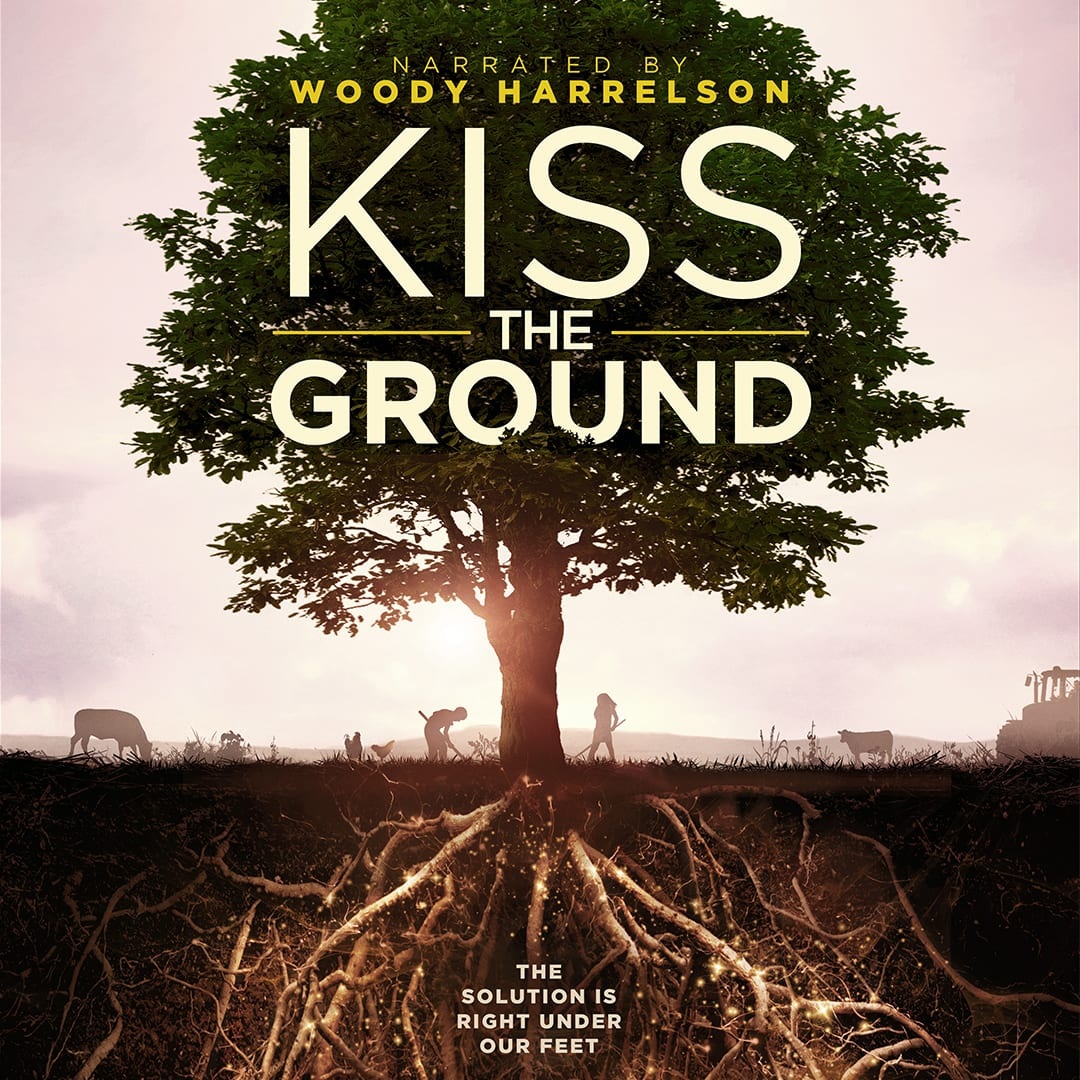The sign at the entrance to the Rodale Institute, an organic research farm in Kutztown, Pennsylvania, reads: “Healthy Soil, Healthy Food, Healthy People.” After watching the new film, Kiss the Ground, I think “Healthy Planet” could also be added to the sign. Like the Rodale Institute, Kiss the Ground focuses on the importance of healthy soil and its vital role in addressing major challenges facing the world today with feeding a growing population and mitigating climate change. Kiss the Ground, which is directed by Josh and Rebecca Tickell, is literally a ground-breaking film that describes in a visually compelling and easy to understand way that the key solution to the climate crisis is literally under our feet.
The film features interviews with experts—scientists, thought leaders, celebrities, and especially farmers, who are doing the work in the ground. Celebrities featured include model and activist Gisele Bündchen, who is an executive producer, her husband, football star Tom Brady, and actress Patricia Arquette, whose work with the non-profit GiveLove is shown.
Narrated by actor and environmental activist Woody Harrelson, the film takes viewers around the world—from Kansas, North Dakota, and California, to France, Zimbabwe, and China to highlight regenerative agriculture and climate drawdown projects.
Ray Archuleta, a conservation agronomist with the U.S. Department of Agriculture’s Natural Resource Conservation Service and a self-described soil health evangelist, is shown giving talks to farmers around the U.S. about the importance of regenerating soil.
“If we get the soil right, we can fix a lot of our issues,” he says. “Healthy soils lead to a healthy plant. A healthy plant leads to a healthy animal, healthy human, healthy water, healthy climate.”
Kristin Ohlson, author of The Soil Will Save Us, describes how plants pull carbon dioxide out of the atmosphere and turn it into a carbon fuel that feeds soil microorganisms which in turn bring the plant nutrients.
Unfortunately, modern “industrial” agriculture with its use of plowing or tilling and dependence on chemical pesticides and fertilizers is releasing that carbon dioxide into the atmosphere, which is wreaking havoc on the planet and the climate.
Dr. Kristin Nichols, a soil microbiologist, talks about the vicious cycle of industrial agriculture. “Soils sprayed with chemicals are devoid of soil microorganisms,” she says.
The film paints a dire picture of the world’s soils. Since the advent of industrial agriculture after the second World War, the world has lost one-third of its topsoil due to plowing and erosion. According to the U.N. the world’s remaining topsoil will be gone in 60 years, which means we have 60 harvests left, as Harrelson says.
“The long-term prognosis for our survival on this planet, given business as usual, is very, very poor,” says Jeff Creque, rangeland director, Carbon Cycle Institute.
But ultimately, the film’s message is hopeful as it focuses on farmers and scientists who are regenerating their lands and sequestering carbon.
North Dakota rancher Gabe Brown, perhaps the best-known regenerative farmer in the U.S., shows his diverse 5000-acre farm and ranch, which has become a model for the effectiveness of regenerative agriculture.
“For every 1% increase of soil organic matter, each acre of soil draws down 10 more tons of carbon,” Brown says.
His strategy for regenerative agriculture is simple. “We have to reduce tillage, grow cover crops, and get living roots in the soil.”
One of the most telling parts in the film is when Brown compares his regenerated land with its diverse plantings of cover crops with his neighbor’s barren brown soil. “There you have soil, here you have dirt,” he says.
Activist and actor Ian Somerhalder travels to Zimbabwe to show how Alan Savory, an ecologist and co-founder of the Savory Institute, has regenerated land using managed grazing of cattle for nine years. The land had previously been a desert but now is green with tall grasses and other vegetation.
“We can get the earth back to the Garden of Eden it once was by regeneration,” Somerhalder says.
Doniga Markegard, a livestock rancher and land steward in Half Moon Bay, California explains how grazing animals contribute to building soils and capturing carbon. “We’re taking carbon from the atmosphere via photosynthesis into the plant and its going through the plant into the root system. Cows will eat the tops of grasses off. When the grasses get bitten off, the roots slough off. That carbon sloughs off and turns into humus where it belongs.”
John D. Liu, an ecologist and filmmaker, describes a dramatic large-scale regeneration project in China’s Loess Plateau, an area the size of Belgium, and one of the most eroded places on the earth. In 25 years, 14,000 square miles were regenerated. Film clips show brown desert conditions devoid of life before and lush green grasses and trees after.
“If we restore all the degraded land on the earth we can return to paradise,” Liu says.
In light of wildfires in the West and hurricanes in the Gulf of Mexico, the message of Kiss the Earth is very timely and needed. The film shows that regenerating the world’s soils and returning to an Eden on earth, a “Healthy Planet,” is possible. It will only take the will and efforts of farmers, policy makers, and perhaps, most importantly, demand from all of us to do it.
Kiss the Ground premiers on Netflix on September 22.









